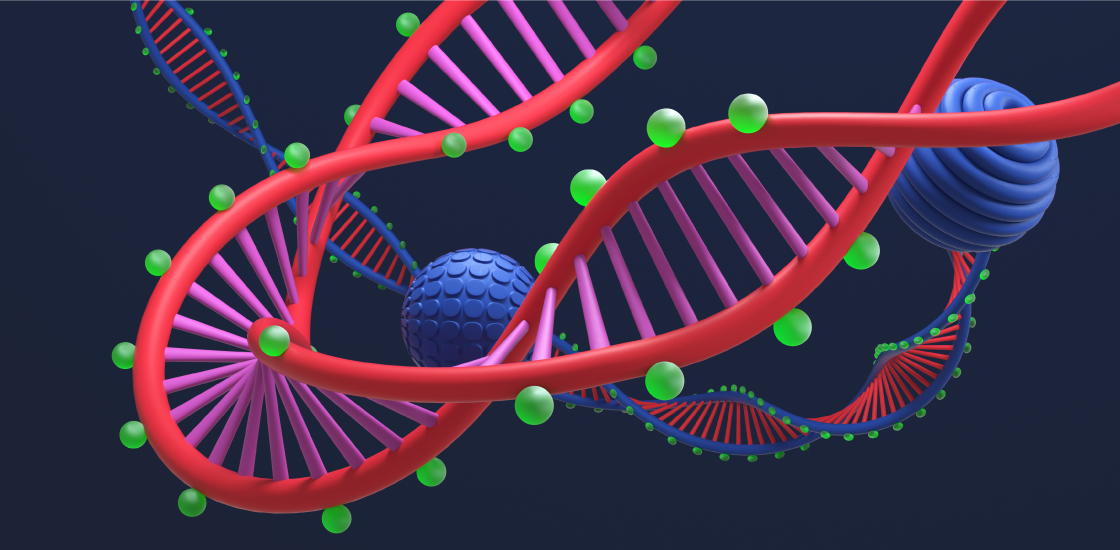Researchers have identified hundreds of genes that may contribute to autism, but these genes can’t fully account for the condition’s traits. Studies from the past decade implicate an additional layer of ‘epigenetic’ complexity: chemical tags called methyl groups laid on top of a person’s genetic code.
Enzymes that are mutated in some people with autism or related conditions attach the chemical tags to DNA. And that pattern of methyl marks across the genome can influence which genes are active or inactive at any given time.
Much remains to be understood about this process, called DNA methylation. Here we describe how and when methylation happens and what researchers know about its relationship to autism.
What is methylation?
Methylation is the process by which enzymes called methyltransferases deposit methyl chemical groups onto DNA. The presence of these tags usually turns off nearby genes. The complete set of such modifications to the genome over a person’s lifetime is known as the methylome.
Most methyl tags are deposited onto the DNA nucleotide called cytosine (C) whenever it occurs next to the nucleotide guanine (G). This CpG methylation begins during gestation and can change across the lifespan. Tags are also sometimes added to cytosines followed by other nucleotides, however. High levels of non-CpG methylation in the brain may be critical for neuron development.
Several environmental factors — including in utero exposure to tobacco smoke or folic acid, the primary component of prenatal vitamins — can influence methylation, says Janine LaSalle, professor of microbiology and immunology at the University of California, Davis. Other potential factors include prenatal exposure to organic pollutants and alcohol, as well as maternal obesity, asthma and stress. The impact of these exposures on methylation may depend on their timing, and those occurring in the first trimester appear to have the most significant effect, LaSalle says.
Do autistic people have different patterns of methylation?
Studies of postmortem brains suggest that autistic people have different methylation patterns — not only in specific genes but across the entire genome — than non-autistic people. These differences are present at birth, prior to diagnosis. For example, autistic people are more likely to demonstrate hypermethylation of genes such as MECP2 and UBE3A; loss-of-function mutations in these genes are strongly linked to autism. Other autism-related patterns include higher levels of methylation marks in genes involved in regulating the immune system, neurons and synaptic signaling.
Because brain tissue storage and degradation after death can affect DNA methylation and postmortem brain samples are limited, other researchers have examined methylation patterns in more readily available tissues, such as the placenta and cord blood. These tissues also have unique methylation signatures that reflect environmental exposures during pregnancy.
“The placenta is like a time capsule of what the baby was exposed to in utero,” LaSalle says. “It’s almost like carbon dating.”
Cord blood and placenta studies show autism-linked methylation changes near genes that regulate brain development and determine the fates of different cell types. These epigenetic changes could be used as a panel of biomarkers to aid early diagnosis and intervention, researchers say. DNA methylation marks in sperm might even help predict a man’s chances of having a child with autism, according to a small study published in January.
Other researchers have attempted to integrate methylation data with other types of molecular data to better understand how these differences correlate with autism traits. In a study published last year, researchers analyzed four types of molecular data — levels of messenger RNA, which is converted into proteins; a small type of RNA called microRNA; methyl groups; and acetyl groups, a type of chemical tag found on the proteins that DNA coils around — gathered from postmortem brains of autistic people and controls. The majority of the autism brains displayed a ‘convergent’ subtype, displaying differences in gene expression and the patterns of chemical tags.
Do methylation patterns vary in different tissue types?
Yes. Different tissues have different functions and thus differences in which genes are expressed. For autism, methylation patterns seen in the blood or saliva do not necessarily correlate with those seen in the brain, which is why DNA methylation marks need to be validated in brain tissue studies.
What causes DNA methylation changes in autism?
Whole-exome and genome-sequencing data from autistic people have identified mutations in DNA that encodes ‘methylation machinery,’ such as the genes DNMT3A and MECP2. These mutations disrupt methylation through loss or gain of function in key enzymes. Environmental factors may also be at play.
How much of the methylome have researchers explored?
Although the methylome has about 28 million CpG sites, current technology has limited studies to an examination of only about 2 to 3 percent of them. These techniques are also biased toward parts of the genome where methylation is likely the least variable, LaSalle says.
A new project, co-led by Karolina Aberg, associate professor of pharmacy at Virginia Commonwealth University in Richmond, Virginia, plans to use a sequencing technology called MBD-seq to explore 28 million sites in blood and brain samples — the most comprehensive study of the methylome to date. This five-year study could help answer lingering questions about how the methylome may change over time, especially in autistic versus non-autistic people, Aberg says.
In addition to technological limitations, what are some other challenges of DNA methylation analysis?
The study participants in various DNA methylation studies may have been taking medications that could have confounded the results. Additionally, as methylation patterns vary across different types of tissues, more studies are needed to confirm what these alterations look like and how they affect function. It is also challenging to tease apart the individual influences of various environmental factors.






